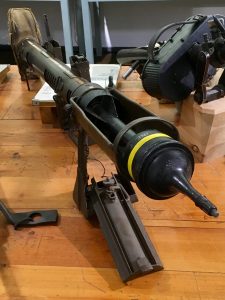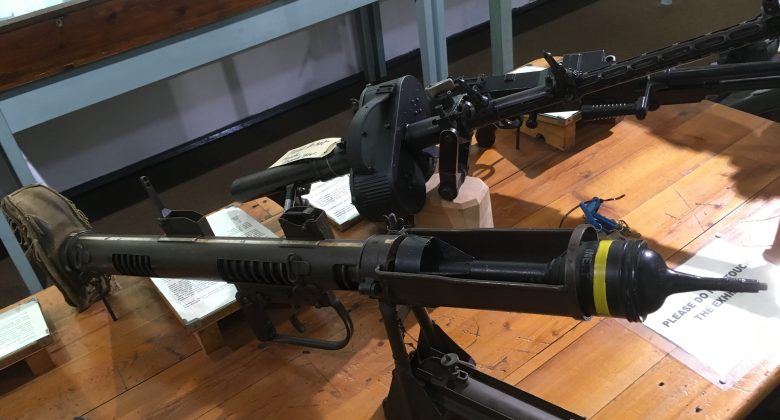THE PIAT (PROJECTOR INFANTRY ANTI-TANK) By Paul Rundle
One of the more unusual weapons on display at Bodmin Keep is the PIAT, which was used effectively by the Duke of Cornwall’s Light Infantry (DCLI) during World War 2. It was developed between 1941 and 1942 by two British Officers, initially by Lt Col. Blacker who created the weapon and later by Major Jefferis who made improvements that turned it into an effective anti-tank weapon against the more heavily armoured German tanks. It was first deployed in Sicily in 1943.
The weapon was 39 inches (0.99m) long, weighed 34 pounds (15.4kg) with an effective range of 115 yards (105m) in the anti-tank role and 350 yards (320m) in an indirect fire house- breaking role, with a muzzle velocity of 250 FP per second.
It consisted of a steel tube, a trigger mechanism and firing spring. It was based on the spigot mortar system; instead of using a propellant to directly fire the round or missile the spring was cocked and tightened, when the trigger was pulled it released the spring which pushed the spigot forward into the rear of the bomb, detonating the propellant and launching the projectile.
The bomb or HEAT (high explosive anti-tank) projectile was 3 pounds in weight (1.35kg) and was an early example of hollow charge ammunition. This consisted of a recessed metal cone placed into an explosive warhead; when the warhead hit its target, the explosive detonated and turned the cone into an extremely high-speed spike. The speed of the spike, and the immense pressure it caused on impact, allowed it to create a small hole in armour plating and send a large pressure wave and large amounts of fragments into the interior of the tank. In theory, this could penetrate 4 inches (100mm) of armour.
Soldiers of small stature struggled to cock the PIAT, inside the tube of the weapon was an enormous spring. The soldier unlatched the shoulder pad, stood on it, gave the weapon a half-turn to unlock the body from the shoulder pad, then lifted the weapon straight up, which cocked the spring with an audible click. He then reattached the shoulder pad with another half-turn, raised the weapon to his shoulder, and took aim. Cocking the PIAT took a lot of strength estimated at a draw weight of 200 pounds (90kg). When fired, the weapon was automatically cocked by recoil created by the propellant charge. Because of the difficulty in cocking the weapon it was not universally popular with the infantry.

The first encounter the 5th Battalion of the DCLI had with German forces in Normandy was on Tuesday 27th June 1944 when they were attacked by six Panther tanks at Le Haut du Bosq near Cheux. The battalion HQ was set up in an orchard at this location when at 09.00 the sound of tanks was heard approaching down the sunken road from the south. Initially they were thought to be allied, but when the lead tank turned the corner it ran into four Royal Artillery 17-pdr. anti-tank guns being towed by carriers to support 5 DCLI, the tank knocked out all four gun units setting them on fire and it became apparent they were German Panther tanks.
Subsequent research would indicate they were six of seventeen Panther tanks from the 1st Battalion /3rd Panzer Regiment of the 2nd Panzer Division and at this time had been seconded to the 12 SS (Hitler Jugend) Panzer Division. As a whole they were making a counter attack against the flank of the British offensive without the support of Panzer-Grenadiers which would prove costly to the tanks subject of this particular engagement.
The other five tanks turned into the orchard and knocked out two 6-pdr. anti-tank guns then headed for Battalion HQ where they engaged trucks, jeeps and carriers setting them on fire.
By this time the German tanks had run themselves into trouble, PIAT teams had been organised and the rear end assault by the PIAT teams had effect. The tanks were hit repeatedly, one fled having been hit three times by the PIAT of Lieutenant Prowse and his team from 17 platoon, it got away badly damaged.
Sgt. Hicks knocked out another at point blank range with his PIAT whilst being fired at by the tank. Two others were confronted by Captain Carlos Leonard Blackwell, his first two shots missed but with four more shots at point blank range he destroyed the tank. The other tank in its hurry to escape turned over.
The fifth tank was destroyed by Sgt. Willison’s 6-pdr, it surprisingly caught fire as this anti-tank gun was not thought capable of knocking out a Panther tank. As a result of this action Captain Blackwell was awarded the Military Cross but this became a posthumous decoration as he was killed on Hill 112 on Tuesday 11th July 1944. Sgt Hicks was also recognised for his part in the action, for his bravery he was awarded the Military Medal.
On 22nd September 1944, on the road between Valburg and Elst, near Arnhem, 5 DCLI destroyed another 5 German tanks, this time Tigers, with a combination of PIATs and Hawkins mines… But this is another story!

